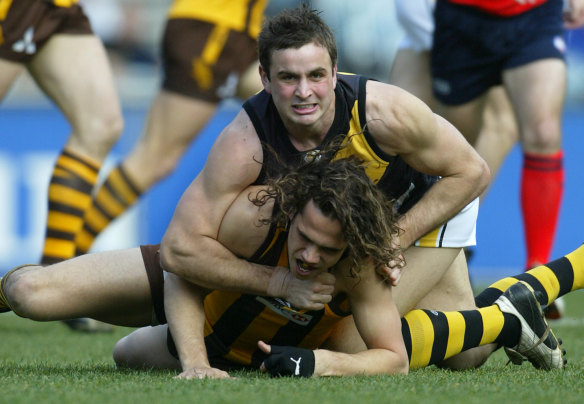
In late January 2004, it was reported in The Age that Bradshaw had left to take up a position with English Premier League club Fulham.
“It’s quite a good time for both [clubs],” Bradshaw, who had been with the Tigers for 12 years, said at the time. “Fulham has been without a club doctor since the start of the year, and it wouldn’t have been fair to Richmond to get too far into the regular season before departing.”
Zantuck alleges he was given injections in his back to “play numb”, a claim Hickey and Bradshaw deny. Zantuck and Hickey are at odds over a text Zantuck allegedly sent to Hickey about 16 years ago seeking access to his medical records.
“He has effectively had his life crippled by his back injury,” Associate Justice Ierodiaconou wrote.
Associate Justice Ierodiaconou added: “RFC, Dr Bradshaw, and Dr Hickey each filed a defence to Mr Zantuck’s first statement of claim. By these defences, it is evident that the defendants contest Mr Zantuck’s back injury and treatment claims.”

Former Richmond player Ty Zantuck tackles Hawthorn’s Mark Williams in 2004.Credit:Sebastian Costanzo
Hickey found Zantuck’s medical records of 2004, but “it appears from a review of those medical records that no written evidence was kept in regards to the injections administered or prescribed by RFC’s doctors. If medical records are missing, then it is not the fault of Mr Zantuck.”
Having filed his initial writ and statement about his back injury in April 2021, Zantuck amended his claim in March 2022, to include “a brain injury arising from concussions”. The brain injury claim is only against the Tigers, although the club says it could yet extend to Bradshaw.
Zantuck’s lawyers, from Griffin Lawyers, have used video evidence of several clashes from 29 games, leading to claims of multiple concussions and brain trauma involving a degenerative disease. Zantuck has previously spoken of having had suicidal thoughts.
Associate Justice Ierodiaconou wrote that “the footage of RFC’s handling of other concussion incidents involving other players is likely to be relevant and highly probative of the absence of a good protocol for managing concussion”.
“The video evidence will show that Mr Zantuck’s experience was similar to other players. It will show how RFC dealt with events that are assessed by medical experts as concussions. There is no evidence from any of the defendants that positively asserts or even suggests that RFC had a concussion management protocol in place at the time. There are just a couple of weekly notes,” Associate Justice Ierodiaconou said in her summation.
“The allegation against RFC in respect of the concussion claim is that it did not have adequate systems or policies for dealing with head injuries. RFC has not provided any evidence as to whether or not it has relevant documentary evidence.”
The AFL and Tigers did not wish to comment. The AFL’s concussion and health-and-safety protocols are now among the world’s best.
Reports by neurologist Dr Rowena Mobbs and neuropsychologist associate professor Jennifer Batchelor “identified the existence of criteria for suspected traumatic encephalopathy syndrome (‘TES’) and evidence of acquired cognitive impairment. TES is the ‘in life’ correlate of chronic traumatic encephalopathy (‘CTE’). The expert scientific evidence is that detectable symptoms generally only emerge later in a person’s life when concussion injuries are sustained in their 20s.”
The defendants argued the deaths of Danny Frawley, coach at the time, and Tigers physiotherapist Ian Macindoe, and former Essendon club doctor Bruce Reid should have led to Zantuck’s case for extra time being denied as their evidence was critical.



























